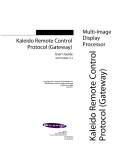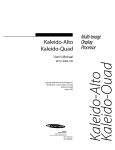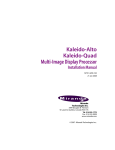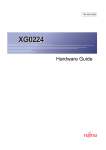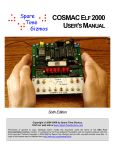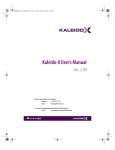Download ViewSonic VX1945 User`s manual
Transcript
Release Notes Kaleido-Alto/Quad/Quad-Dual Version 3.31 Part Number: M785-0203-115 Please read this notice carefully before upgrading your Kaleido-Alto, Kaleido-Quad, or Kaleido-Quad-Dual The Kaleido-Alto-HD provides 10 auto-sensing inputs capable of detecting HD-SDI, SD-SDI as well as composite video signal. The Kaleido-Quad-HD and Kaleido-Quad-Dual-HD are scaled-down versions of the Kaleido-Alto-HD, with only 4 inputs. This software release (version 3.31) resolves minor issues, and is compatible with KEdit version 5.22, 5.30 MR2, 5.40 or higher. An updated online documentation set for KEdit is included since version 3.30. Please refer to the ReadMeFirst.txt file located under Kaleido-Alto-Quad V3.31\Software Backup, on the Kaleido-Alto/Quad/Quad-Dual CD-ROM. Among other important information, the ReadMeFirst file explains how to install the updated KEdit documentation (if you have not had a chance to do it already). Before proceeding with the upgrade, make sure your Kaleido-Alto/Quad/Quad-Dual CompactFlash card has at least 15 MB of free space. This information is available in the System Status window of the KaleidoAlto/Quad/Quad-Dual. On the K-Alto, Quad or Quad-Dual menu, click Status to view the System Status window. If there is not enough free space on the CompactFlash (CF) card, there are two options: • Purchase a higher-capacity CF card to avoid this problem in the future. Follow the software backup procedure to get started with the new card. The recommended models that have been tested by Miranda are listed below. SanDisk CompactFlash Model Number • Capacity SDCFJ-64-388 64.2 MB SDCFJ-128-388 128.4 MB SDCFJ-256-388 256.9 MB SDCFJ-512-388 512.5 MB SDCFJ-1024-388 1024.9 MB Proceed with a manual upgrade and follow the software backup procedure (in this case you don't need 15 MB of free space). The software backup procedure is described in the ReadMe.txt file located under Kaleido-Alto-Quad V3.31\Software Backup, on the Kaleido-Alto/Quad/Quad-Dual CD-ROM. NOTE: For the Kaleido-Alto/Quad cascade operation and configuration, please refer to the “Alto/Quad Cascade Step-by-Step Configuration Guide” (M785-0604-102) shipped on the Alto/Quad/Quad-Dual 3.31 CD-ROM. Release Notes Kaleido-Alto/Quad/Quad-Dual Version 3.31 Version 3.31 Fixes • (B19597) The WSS information present on 625-line analog video signals is not decoded. Version 3.30 New Features • • • • • • Support for the AFD (Video Index), WSS, and AFD (SMPTE 2016) video format descriptors. Automatic aspect ratio conversions: a video monitor’s aspect ratio can be slaved to the input format; a video raster’s aspect ratio can be set to follow AFD/WSS indicators. Support for bidirectional (v.g. Arabic) input in text labels and UMD text. Support of DVI input trough the use of the KXI-DVI-Bridge device connected upstream to a KaleidoAlto/Quad input. Two new input resolutions: 1080p 29.97Hz, and 1080p 23.98Hz. Ability to synchronize the unit’s internal clock to an external NTP source. Fixes • • • • • • • (B9422) When using the optional Monitoring Output card in 10×1 mode to monitor an HD signal, switching to scan converter mode and then going back to 10x1 mode will make the signal disappear. (B14794) When using timing offsets larger than 15 hours you need to enter a different value in KEdit in order to obtain the proper offset on the Kaleido-Alto/Quad/Quad-Dual. (B15215) The <setKAudioOut> Gateway command does not work with input 10, neither for embedded nor for audio card inputs. (B18263) Alarms from the right embedded audio channel are not reported. (B18862) In a cascaded system, after opening the System Status, Audio Settings, or Video Settings window on the master unit, alarms from the slave units are not reported anymore. (B19046) Every action triggered by an Alarm Monitor could be performed repeatedly, if one of the actions involves loading a Layout. (B19099) GPI Out actions assigned to GPI Output 10 do not work. Version 3.21 New Features • Additional status information about the network configuration (DHCP or static IP address). Fixes • • • • • • • 2 (B14426) After a change of resolution or a layout export, the Kaleido-RCP and the KaleidoAlto/Quad/Quad-Dual may stop communicating with each other. (B14239) Overscan mode is not available with HD sources. (B15216) Analog audio “Gain” control is not functional. (B15215) An audio monitoring selection using a remote control command from the “Gateway” is not functional. (B9276) The following remote control commands from the “Gateway” do not send an ACK response: <openID>IP_ADDRESS_0_4_0_0</openID> <openID>IP_ADDRESS</openID> (B15473) It is possible to make audio monitoring selections that conflict with each other. (B15450) There are problems with short Ethernet cables (now any cable length is supported). Part Number: M785-0203-115 Updated: 3 October 2008 Release Notes • • Kaleido-Alto/Quad/Quad-Dual Version 3.31 (B15454) Alarms, channels, actions or audio scales exported with layouts from KEdit to a KaleidoAlto/Quad may not synchronize properly. (B13613 and B15526) Loss of a dynamic UMD from TSL may occur when using channel assignments or changing view to full screen. Version 3.20 New Features • • Support for the new Kaleido-Dual Quad series, which includes: o Kaleido-Quad-Dual-HD (HD/SD-SDI and Composite Dual Quad Split Processor w/redundant PSU) o Kaleido-Quad-S-HD-R (HD/SD-SDI and Composite Quad Split Processor w/redundant PSU) Shortcut to return to default resolution (1280 x 1024 @ 60 Hz): Press Ctrl+Alt+R on a USB keyboard connected to the unit. Fixes • • • • • • (B14458) Changing output resolution sometimes doesn’t work (system returns to the default resolution of 1280 x 1024 @ 60 Hz). (B14459) Some output resolution timings are inexact. (B14545) Not able to select “PC in” audio input for audio monitoring output. (B14804) TSL service, Andromeda service and any Remote Control Commands cannot trigger tallies. (B14805) Potential problem (crashes) when using Gateway alarms and texts with the same addresses within a layout. (14832) White dots in the Analog clock don’t display properly. Version 3.10 New Features • • Kaleido-Alto/Quad/Quad-Duals can now be configured to operate in cascade mode for up to 30 inputs on one display. (B12633) A Kaleido-Alto/Quad/Quad-Dual can now decode and display the VITC from video sources. Fixes • (B12635) A line of noise appears at the bottom of the screen when setting the underscan mode This problem has been fixed in version 3.10 via a firmware update. Frequently Asked Questions (FAQ) Q. Does the Kaleido-Alto/Quad/Quad-Dual come with a fixed IP address? A. By default, the Kaleido-Alto/Quad/Quad-Dual is configured using DHCP. However, a fixed address can be entered in the Network Configuration panel (see the User’s Manual for more information). Q. Is it possible to upgrade the Kaleido-Alto-A, D and AD with version 2.1 or is new hardware needed? A. Yes, an upgrade is possible. Visit http://www.miranda.com/portal/downloads.php to get the latest version available. The upgrade package consists of firmware and software files that can be transferred from a client PC via TCP/IP to a Kaleido-Alto, Layout and configuration files are not affected by the upgrade. Updated: 3 October 2008 Part Number: M785-0203-115 3 Release Notes Kaleido-Alto/Quad/Quad-Dual Version 3.31 Q. Using the “10 x 1” or “4 x 1” SDI internal routing switcher with the MWO-SDM or MWO-HDM, what happens if I accidentally select a composite source? A. Composite signals are not supported due to hardware limitations. Selecting a composite signal via the router may result in unstable output or even complete black. Select a valid SDI signal to re-establish proper output. Supported Output Resolutions (Factory) Resolution 800 x 600, 50 Hz1 VGA and DVI-I Output √ 800 x 600, 60 Hz1 √ Full 1024 x 768, 50 Hz √ Full 1024 x 768, 60 Hz √ Full 1280 x 768, 50 Hz √ Full 1280 x 768, 60 Hz √ Full 1360 x 768, 50 Hz √ Full 1360 x 768, 60 Hz √ Full 1280 x 1024, 50 Hz √ Full 1280 x 1024, 60 Hz 1 2 Display mode Full √ Full 1920 x 1080, 50 Hz 2 √ w/letter boxes 1920 x 1080, 60 Hz 2 √ w/letter boxes 1600 x 1200, 50 Hz 2 √ w/letter boxes 1600 x 1200, 60 Hz 2 √ w/letter boxes The 800 x 60 resolutions are only supported in Standalone mode. The 1920 x 1080, and 1600 x 1200 resolutions are only supported on systems with hardware revision 200 “Enhanced” or later. Supported Output Resolutions (Custom) Some display models have different timing parameters than what is provided with the factory-installed resolution definitions. To use one of the display models listed below, the corresponding resolution files must be added to your Kaleido system. Please refer to the ResolutionProcedure.txt file located under Kaleido-Alto-Quad V3.31\Resolutions, on the Kaleido-Alto/Quad/Quad-Dual CD-ROM, for detailed instructions. Brand Sanyo Apple Barco Panasonic Samsung Sanyo Sharp 4 Model PLV-Z4 Cinema HD (30 inches) Cinema (20 inches) Cinema HD (23 inches) OverView cDR+67-DL OverView cDR+67-DL TH-50PX60u TH-65PHD TH-65PHD 8EK HL-S4266W LA40F71B LN-S5797D PLV-Z4 Aquos LC32D62U Resolution 1280x720, 50 Hz 1280x800, 60 Hz 1680x1050, 60 Hz 1920x1200, 60 Hz 1400x1050, 50 Hz 1400x1050, 60 Hz 1280x720, 60 Hz 1366x768, 60 Hz 1366x768, 60 Hz 1280x720, 60 Hz 1920x1080, 60 Hz 1920x1080, 60 Hz 1280x720, 60 Hz 1360x768, 60 Hz Part Number: M785-0203-115 Updated: 3 October 2008 Release Notes Brand Sony ViewSonic Kaleido-Alto/Quad/Quad-Dual Model Aquos LC32D62U LMD-232W Bravia KDL-26M3000 Bravia Bravia LMD-2450W VX1945 VX1945 VG2230 VG2230 VX2025wm Version 3.31 Resolution 1920x1080, 60 Hz 1280x768, 60 Hz 1360x768, 60 Hz 1920x1080, 50 Hz 1920x1080, 60 Hz 1920x1200, 60 Hz 1440x900, 60 Hz 1440x900, 50 Hz 1680x1050, 50 Hz 1680x1050, 60 Hz 1680x1050, 60 Hz Supported Embedded Time Code Formats and Alarms Embedded Time Code Format Hardware revision1 VITC DVITC ATC Black/Freeze/Luma Alarms Kaleido-Alto-A2 Kaleido-Alto-AD2 Kaleido-Alto-HD Kaleido-Quad-AD Kaleido-Quad-HD 100 - 200 200* 100 - 200 200* 100 - 200 200* 300 or later 300 or later 300 or later 300 or later 300 or later Not Supported Not Supported Not Supported Not Supported Not Supported Not Supported Supported Supported Supported Supported Supported Not Supported Not Supported Not Supported Not Supported Not Supported Not Supported Not Supported Supported Supported Supported Supported Not Supported Not Supported Not Supported Not Supported Not Supported Not Supported Not Supported Not Supported Supported Not Supported Supported Not Supported Not Supported Not Supported Not Supported Not Supported Not Supported Supported Supported Supported Supported Supported Kaleido-Quad-Dual All Supported Supported Supported Supported Kaleido Model Kaleido-Alto-A Kaleido-Alto-D Kaleido-Alto-AD 1 200 = v. 200 base version; 200* = v. 200 enhanced version Known Issues and Limitations Clock time zone Issue: When using the unit’s internal clock as the time reference for clock components, occasionally the time zone will not be applied properly. Workaround: Right-click the clock component, and then click Clock Settings on the shortcut menu. Select the appropriate time zone again, and then click OK. Save the layout. Daylight saving time Issue: The internal clock does not support daylight saving mode. Workaround: During daylight saving time, specify the appropriate time offset for all the clock components in your layouts that are configured to use the unit’s internal clock as the time reference. Remember to save each Updated: 3 October 2008 Part Number: M785-0203-115 5 Release Notes Kaleido-Alto/Quad/Quad-Dual Version 3.31 modified layout before moving on to the next one. Alternatively, set your system’s date and time configuration to a different time zone (click the K-Alto, Quad, or Quad-Dual button, point to Settings, and then click Date/Time). Internal clock Issue: When using the unit’s internal clock as the time reference for clock components, there could be a variation of up to 10 seconds over a 24-hour period. Workaround: Use an external LTC reference input, or synchronize the internal clock to an external NTP source. MWO-SDM (Mezzanine) output permits illegal video black levels Limitation: The MWO-SDM mezzanine outputs graphics and video from the Kaleido-Alto/Quad/Quad-Dual as an HD video signal. If any of the graphics from the Kaleido-Alto/Quad/Quad-Dual use black values below RGB 16, 16, 16, or if the “Expand Video Dynamic Range” option has been applied in KEdit, the MWO-SDM allows these illegal values to pass through its video output. Workaround: If you are using the output of the MWO-SDM, do not enable the “Expand Video Dynamic Range” option in KEdit. Make sure that graphic elements don’t use RGB values below 16 (i.e. for black, use RGB 16,16,16, not 0,0,0). Full screen setting lost after reboot Issue: If a Kaleido-Alto/Quad/Quad-Dual view is set to full screen and then rebooted, the display view will return to the view setting that existed prior to the full screen view. The same occurs following a change in resolution. Video calibration Issue: For SDI inputs configured to de-interlace in the temporal mode, the sharpness control is not active. Issue: For 1080p 23.98Hz and 1080p 29.97Hz inputs, the Duration, Occurrence, and Detection Window calibration parameters specified for Black/Freeze/Luma error detection are ignored. Audio threshold precision Issue: Audio threshold precision is +/- 1 dB. Updating from previous version Issue: When updating your Kaleido-Alto/Quad/Quad-Dual it may happen that the task bar becomes red and displays an error message. Workaround: Press the Reboot button located at the right end of the task bar to restart the system. 6 Part Number: M785-0203-115 Updated: 3 October 2008 Release Notes Kaleido-Alto/Quad/Quad-Dual Version 3.31 IP address reverts to DHCP after upgrading Issue: After upgrading the Kaleido-Alto/Quad/Quad-Dual, the “Registry” will be reset and the IP address of the Kaleido-Alto/Quad/Quad-Dual will be reset to an address from the DHCP server. This occurs only if upgrading from a version prior to 3.0. Workaround: Access the Network Configuration window on the Kaleido-Alto/Quad/Quad-Dual, and reset the address to your own fixed IP address after the upgrade is completed. Countdown timer resizing Issue: In KEdit the user can insert a countdown timer in a layout without any size restriction. The countdown timer can then be resized smaller than the minimum size displayable on the Kaleido-Alto. In this case, the countdown timer will be displayed at its minimum size by the Kaleido-Alto software. Workaround: Modify the layout by making the countdown timer larger and repositioning it. SECAM video signal is not recognized Issue: The Kaleido-Alto/Quad/Quad-Dual system is not able to monitor black, freeze, or luma alarms on a SECAM video signal. Workaround: To be able to monitor black, freeze, and luma, use the Y-only (black & white) portion of the SECAM signal as an input to the Kaleido-Alto/Quad/Quad-Dual. Dot crawl with high chrominance and luminance values Issue: When maximum values of luminance and chrominance are set, dot crawl may be visible on a video component. Workaround: Change luminance and chrominance levels to lower values. Problem with layout download and SNMP traps transmission Issue: IP negotiation problems can occur when a Kaleido-Alto/Quad/Quad-Dual is set to handle data at 100 Mbps. This IP configuration may affect layout downloads or SNMP trap transmission. Workaround: Hard reboot the unit to fix the problem, or leave the setting at 10 Mbps for optimal operation. During the boot-up sequence, only master Kaleido will display video images Issue: During the boot-up of Kaleido frames in a cascade configuration, only the master frame will display video images. Updated: 3 October 2008 Part Number: M785-0203-115 7 Release Notes Kaleido-Alto/Quad/Quad-Dual Version 3.31 Contact Us! Miranda Technical Support For technical assistance, please contact the Miranda Technical Support centre nearest you: Americas Office hours: Telephone: Fax: E-mail: Asia 9:00 a.m. – 9:00 p.m. (EST) +1-800-224-7882 +1-514-335-1614 [email protected] Office hours: Telephone: Fax: E-mail: Europe, Middle East, Africa, UK China Office hours: Telephone: Fax: E-mail: Telephone: E-mail: 9:00 a.m. – 6:00 p.m. (GMT) +44 (0) 1491 820222 +44 (0) 1491 820002 [email protected] 9:00 a.m. – 5:00 p.m. (GMT+8) +852-2539-6987 +852-2539-0804 [email protected] +86-10-5873-1814 [email protected] France Office hours: Telephone: Fax: E-mail: 9:00 a.m. – 5:00 p.m. (GMT+1) +33 1 55 86 87 88 +33 1 55 86 00 29 [email protected] Corporate Head Office Miranda Technologies Inc. 3499 Douglas-B.-Floreani, St-Laurent, Quebec, Canada H4S 1Y6 Telephone: 514-333-1772 Fax: 514-333-9828 Web: www.miranda.com 8 Part Number: M785-0203-115 Updated: 3 October 2008










